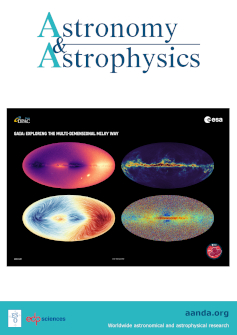Evidence for bipolar explosions in Type IIP supernovae
IF 5.4
2区 物理与天体物理
Q1 ASTRONOMY & ASTROPHYSICS
引用次数: 0
Abstract
Aims. Recent observations of core-collapse supernovae (SNe) suggest aspherical explosions. Globally, aspherical structures in SN explosions are thought to encode information regarding the underlying explosion mechanism. However, the exact explosion geometries from the inner cores to the outer envelopes are poorly understood.Methods. Here, we present photometric, spectroscopic, and polarimetric observations of the Type IIP SN 2021yja and discuss its explosion geometry in comparison to those of other Type IIP SNe that show large-scale aspherical structures in their hydrogen envelopes (SNe 2012aw, 2013ej and 2017gmr).Results. During the plateau phase, SNe 2012aw and 2021yja exhibit high continuum polarization characterized by two components with perpendicular polarization angles. This behavior can be interpreted as being due to a bipolar explosion, where the SN ejecta is composed of a polar (energetic) component and an equatorial (bulk) component. In such a bipolar explosion, an aspherical axis created by the polar ejecta would dominate at early phases, while the perpendicular axis along the equatorial ejecta would emerge at late phases after the photosphere in the polar ejecta has receded. Our interpretation of the explosions in SNe 2012aw and 2021yja as bipolar is also supported by other observational properties, including the time evolution of the line velocities and the line shapes in the nebular spectra. The polarization of other Type IIP SNe that show large-scale aspherical structures in the hydrogen envelope (SNe 2013ej and 2017gmr) is also consistent with the bipolar-explosion scenario, although this is not conclusive.IIP 型超新星双极爆炸的证据
目的。最近对核心塌缩超新星(SNe)的观测表明,它的爆炸是非球面的。总体而言,SN爆炸中的非球面结构被认为编码了有关潜在爆炸机制的信息。然而,人们对从内核到外包层的确切爆炸几何结构知之甚少。在此,我们展示了对IIP型SN 2021yja的光度、光谱和偏振测量观测结果,并将其爆炸几何形状与其他在氢包层中显示大尺度非球面结构的IIP型SNe(SNe 2012aw、2013ej和2017gmr)的爆炸几何形状进行对比讨论。在高原阶段,SNe 2012aw 和 2021yja 表现出高连续极化,其特征是具有垂直极化角的两个分量。这种行为可解释为双极爆炸所致,即SN喷出物由极地(高能)成分和赤道(体积)成分组成。在这种双极爆炸中,由极地喷出物产生的非球面轴将在早期阶段占主导地位,而沿赤道喷出物的垂直轴将在极地喷出物中的光球消退后的晚期阶段出现。我们将SNe 2012aw和2021yja中的爆炸解释为双极化也得到了其他观测特性的支持,包括线速度的时间演化和星云光谱中的线形。其他在氢包层中显示出大尺度非球面结构的IIP型SNe(SNe 2013ej和2017gmr)的极化也与双极-爆炸情景相一致,尽管这还不是定论。
本文章由计算机程序翻译,如有差异,请以英文原文为准。
求助全文
约1分钟内获得全文
求助全文
来源期刊

Astronomy & Astrophysics
地学天文-天文与天体物理
CiteScore
10.20
自引率
27.70%
发文量
2105
审稿时长
1-2 weeks
期刊介绍:
Astronomy & Astrophysics is an international Journal that publishes papers on all aspects of astronomy and astrophysics (theoretical, observational, and instrumental) independently of the techniques used to obtain the results.
 求助内容:
求助内容: 应助结果提醒方式:
应助结果提醒方式:


